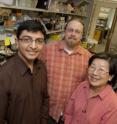Protein libraries in a snap
A Rice University undergraduate will depart with not only a degree but also a possible patent for his invention of an efficient way to create protein libraries, an important component of biomolecular research. Rice senior Manan Mehta discovered a method to create libraries of "circularly permuted" proteins at the suggestion of his mentor, bioengineer Jonathan Silberg. The research was reported this week in the journal Nucleic Acids Research.
In a process Manan calls "permutation using transposase engineering" (PERMUTE for short), he created variations of a protein, in this case, adenylate kinase, that have their amino acids rearranged. The library of mutant proteins was then mined for variants that retained the ability to function by introducing them into Escherichia coli bacteria.
Libraries are particularly useful for scientists who study the rules governing the adaptation of proteins during molecular evolution; they also are useful for designing biosensors and molecular switches with novel functions for synthetic biology, according to the authors.
Creating such a library has traditionally required painstaking processes, said Silberg, an assistant professor of biochemistry and cell biology at Rice.
"Existing methods for rearranging the bits of information in a protein are slow and arduous to use," he said. "In addition, they are non-ideal because they simultaneously create multiple types of mutations, the desired rearrangements and undesired deletions of important amino acids.
"But with our method, you only generate mutants with rearranged sequences, and you don't need to be an expert in biomolecular engineering. All you need is the DNA that encodes your gene of interest, the artificial minitransposon we engineered and an enzyme. Mix them all together and you get a library of every possible variant.
"It's a way of making, with great control, all of the diversity of this type of mutation that could exist in a protein."
Proteins, strings of amino acids that regulate biological processes, are created in cells. They have a beginning -- the "N" terminus -- and an end -- the "C" terminus. "The 'N' comes off the ribosome first and builds up from there," Silberg said. "Then the proteins fold, like a ball of string. We connect the two ends of the string and break it elsewhere."
"There's already an enzyme that does most of the work for you," Mehta said. "It's called a transposase, and it inserts the transposon. The hard part is making the transposon itself, which is really just a big piece of DNA."
Since beginning the project last spring, Mehta has spent half his time in Silberg's lab modeling his minitransposon at the computer and half implementing his ideas on the bench. The long process of creating the minitransposon involved building his designed DNA and debugging it so that it functioned as intended.
"We ended up with 15 unique variants of permuted adenylate kinase after sequencing 220 or so, about half of which were active and half not. It's quite an ordeal," he said, citing the patient assistance of co-author Shirley Liu, a research technician in Silberg's lab.
"The synopsis is, it's a new way of mutating protein in a controlled way," Silberg said. "I want to make it simple. It's clear when you make the libraries that there's going to be useful diversity in there, but we're not smart enough to know which mutations to make -- so we still need to make the libraries. Making a better library makes it more likely that we'll find what we want."
The work was supported by the National Aeronautics and Space Administration and the Robert A. Welch Foundation.
Source: Rice University
Other sources
- Protein libraries in a snapfrom Science DailyFri, 10 Feb 2012, 19:30:35 UTC
- Protein libraries in a snapfrom PhysorgFri, 10 Feb 2012, 12:00:47 UTC

